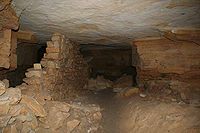- Odessa Catacombs
-
The Odessa Catacombs are an estimated 2,500 kilometres of labyrinths stretching out under the city and surrounding region of Odessa, Ukraine. The majority of the catacombs are the result of stone mining.
Most of the city's 19th century houses were built of limestone mined nearby. Abandoned mines were later used and widened by local smugglers. This created a gigantic labyrinth of underground tunnels beneath Odessa, known as the "catacombs".
Today they are a great attraction for extreme tourists, who explore the tunnels despite the dangers involved. Such tours are not officially sanctioned because the catacombs have not been fully mapped and the tunnels themselves are unsafe. There have been incidents of people becoming lost in the tunnel network, and dying of dehydration or rockfalls.
Only one small portion of the catacombs is open to the public, within the "Museum of Partisan Glory" in Nerubayskoye, north of Odessa.[1]
The tunnels are often cited as the reason why a subway system has never been built in Odessa.[citation needed]
Contents
Composition
Most (95-97 %) of the catacombs are former limestone mines, from which stone was extracted to construct the city above. The remaining catacombs (3-5%) are either natural cavities, or were excavated for other purposes such as sewerage.
History
The first underground stone mines started to appear in the 19th century, while vigorous construction took place in Odessa. They were used as a source of cheap construction materials. Limestone was cut using saws, and mining became so intensive that by the second half of the 19th century, the extensive network of catacombs created many inconveniences to the city.[citation needed]
After the Russian Revolution of 1917, stone mining was banned within the central part of Odessa (inside the Porto-Franko zone, bounded by Old Port Franko and Panteleymonovskaya streets).
During World War II the catacombs served as a hiding places for Soviet partisans, in particular the squad of V.A. Molodtsev. In his work The Waves of The Black Sea, Valentin Kataev described the battle between Soviet partisans against fascist invaders, underneath Odessa and its nearby suburb Usatovo.
In 1961 the "Search" (Poisk) club was created in order to explore the history of partisan movement among the catacombs. Since its creation, it has expanded understanding of the catacombs, and provided information to expand mapping of the tunnels.
Since the beginning of the 21st century limestone mining has continued in the mines located in Dofinovka, Byldynka, and "Fomina balka" near Odessa. As the result of continued mining, the catacombs continue to expand.
Gallery
See also
- Battle of Odessa (1941)
- Znojmo Catacombs
References
External links
- "The Odessa catacombs. Excursions to Odessa catacombs". The Odessa catacombs. Excursions to Odessa catacombs. http://catacombs.od.ua. Retrieved 2011-03-01. (Russian)
- "Excursion to wild catacombs". Excursion to wild catacombs. http://move.in.ua/en/odessa/what-to-do/6-podzemnyj-gorod-katakomby.html. Retrieved 2011-01-01. (English)
- "The Odessa Catacombs". The World Odessit Club. http://odessitclub.org/en/archives/dallin/chapter_6.html#Catacombs. Retrieved 2006-09-23.
- "Odessa Catacombs". http://www.odessa-katakomb.narod.ru/. Retrieved 2006-09-23. (Russian) Photos of the catacombs
Attractions in Odessa, Ukraine Arcadia Beach · Vorontsov's Palace · Botanical Gardens · Catacombs · Odessa City Hall · Chornomorets Stadium · Deribasovskaya Street · Film Studio · Londonskaya Hotel · Bristol Hotel · Opera Theater · Odessa Passage · Pushkin Museum · Sea Port · Odessa Station · Odessa University · Park Pobedy · Philharmonic Theater · Potemkin Stairs · Primorsky Boulevard · Privoz Market · Saviour Cathedral · Seventh-Kilometer Market · Shevchenko Park · Vorontsov Lighthouse · Museum of the Cinema
Categories:- Caves of Ukraine
- Buildings and structures in Odessa, Ukraine
- Catacombs
- Ukrainian building and structure stubs
Wikimedia Foundation. 2010.








